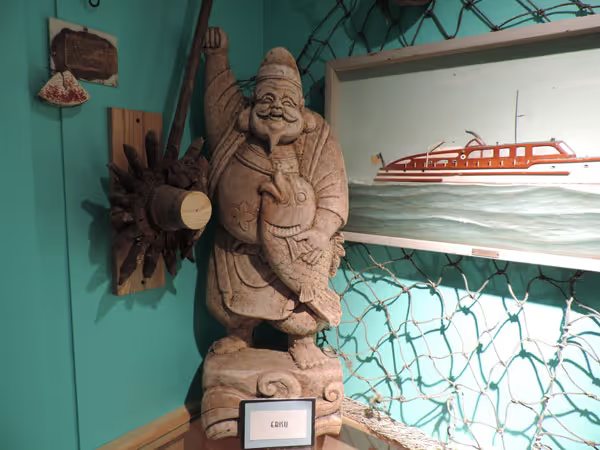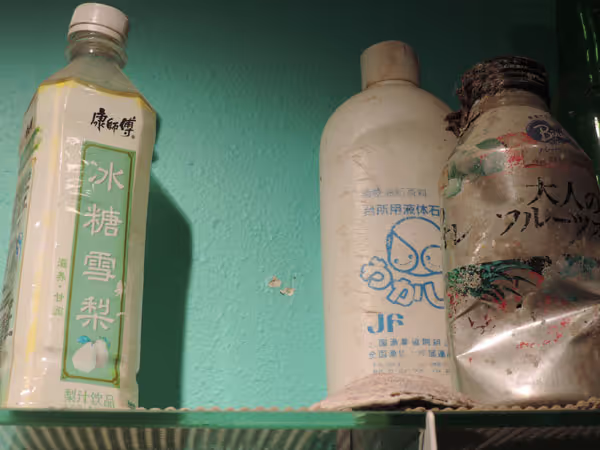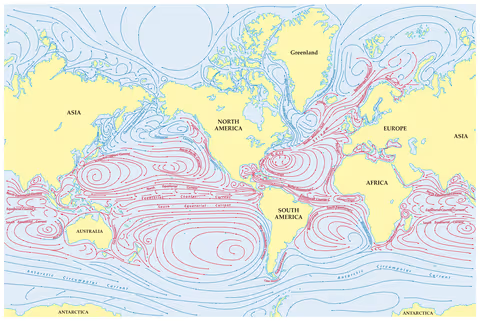The North Pacific Gyre, or How Ebisu Came to Ocean Shores


If you’ve been to the center, you’ve probably seen the wooden Ebisu statue. The Japanese God of Fortune currently resides in our beachcombing exhibit, smiling upon all who enter. The statue was found in 2013 by Nick and Merrilu Sparango, their daughter Allison, their grandson Noah, and their dog Annie. It was truly the beachcombing find of a lifetime.
It is speculated that the statue came over as a result of the Tōhoku Earthquake and Tsunami. The magnitude 9.1 earthquake occurred on March 11, 2011 and caused a tsunami with a maximum wave height of 130 feet which impacted a 1,242 mile length of Japan’s Pacific Coast. Over 18,000 people died. 98 percent of the damage is attributed to the tsunami and an estimated 5 million tonnes of debris entered the ocean as a result of this catastrophic event (NOAA 2021; Loomis 2018).
One of the reasons Ebisu’s arrival is attributed to the Tōhoku Earthquake is because other Japanese objects washed up on North American beaches around the same time. Most notably part of a torii gate (a gate that marks the entrance of a Shinto shrine) was found in Oceanside, Oregon a mere four days after the Ebisu statue was found (Nelson and Kyodo 2013).
Another is that there was an overall increase in debris washing up on North American beaches following the disaster. At NOAA’s marine debris monitoring sites, including the nearby Olympic Coast National Marine Sanctuary, there was a tenfold increase in debris from 2012 to 2015 (Loomis 2018).
An item from East Asia washing up here on the Washington Coast is not an uncommon occurrence under normal circumstances, though these items are often more mundane. For instance, last year I found a Korean apple juice bottle with a 2013 copyright date in Copalis after an average winter storm. You can see similar bottles at the center, just to the right of Ebisu.

So how do objects from East Asia make their way to the North American Pacific Coast? By way of the North Pacific Gyre.
In oceanography, a gyre is a system of large currents which rotate in a circular formation. They are shaped by wind patterns, forces created by the Earth’s rotation, and Earth’s landmasses. There are five major gyres on Earth: the North and South Pacific Gyres, the North and South Atlantic Gyres, and the Indian Ocean Gyre.

The North Pacific Gyre, as the name suggests, is located in the North Pacific Ocean and consists of four currents rotating clockwise. It is a subtropical gyre, which form between the polar and equatorial regions of Earth and tend to be larger than other gyres. The North Pacific Gyre encircles an area about 7.7 million square miles in size.
The westernmost current is the Kuroshio Current. Kuroshio, which translates to “black tide”, is named for its dark waters. The current begins in the Philippine Sea and travels north through the coast of Taiwan, the Ryukyu Islands, and the southeast coast of Japan before veering east to into the North Pacific Current (NASA 2010). There are several smaller currents around Japan that could bring objects from China and the Korean Peninsula into the North Pacific Gyre, such as the Tsushima Current and the Liman Current.
The North Pacific Current flows eastward across the Pacific Ocean. It runs about 30-50 degrees north of the equator. It then splits into two currents which run along the North American Pacific Coast: the Alaskan Current and the California Current, the latter of which is the easternmost edge of the North Pacific Gyre.
The California Current runs southward along the North American Pacific Coast from southern British Columbia to Baja California Sur. This current has strong upwelling zones during the spring and summer months and a northward-running countercurrent called the Davidson Current, which is only prevalent during the winter months. Upwelling tends to move objects on the ocean’s surface away from the coast while the Davidson Current move objects toward it.
The North Equatorial Current it is located about 15 degrees north of the equator and runs west between Central America and the Philippines. This current can be found in the Atlantic and Indian Oceans as well, though it has a different distance from the equator depending on the ocean.
Ebisu is the god of luck, prosperity, and fishermen. He is one of the Seven Gods of Fortune in Japanese mythology and the only one completely of Japanese origin. These traits make him a popular figure in Japanese culture, with many homes and businesses having statues or other iconography of him.
The circumstances that lead to our statue leaving Japan are devastating, to put it mildly. However, as about 70 percent of marine debris sinks to the bottom of the ocean, it is quite incredible he managed to make it to our shores with relatively little damage (Evers 2019). His presence truly makes one marvel at the wonders our oceans are capable of.
References
Caryl-Sue, & MacPhee, M. (Eds.). (2012, October 09). Ocean gyre. Retrieved July 15, 2021, from https://www.nationalgeographic.org/encyclopedia/ocean-gyre/
Collins, C., Pennington, J., Castro, C., Rago, T., & Chavez, F. (2003). The California current system off Monterey, California: Physical and biological coupling. Deep Sea Research Part II: Topical Studies in Oceanography, 50(14-16), 2389-2404. doi:10.1016/s0967-0645(03)00134-6
Evers, J. (Ed.). (2012, October 09). Great Pacific garbage patch. Retrieved July 16, 2021, from https://www.nationalgeographic.org/encyclopedia/great-pacific-garbage-patch/
Fulton-Bennett, K. (n.d.). Seasons in the sea - Winds, waves, and currents in January and February. Retrieved July 18, 2021, from http://www.seasonsinthesea.com/jan-feb/phys.shtml
Loomis, I. (2018, February 19). A tsunami of trash. Retrieved July 18, 2021, from https://www.hakaimagazine.com/news/a-tsunami-of-trash/
National Oceanic and Atmospheric Administration. (2021, March 10). On this Day: 2011 Tohoku earthquake and tsunami. Retrieved July 13, 2021, from https://www.ncei.noaa.gov/news/day-2011-japan-earthquake-and-tsunami
Nelson, A., & Kyodo. (2013, March 26). Tohoku artifacts reach U.S. coast. Retrieved July 13, 2021, from https://www.japantimes.co.jp/news/2013/03/27/national/tohoku-artifacts-reach-u-s-coast/
Vizcarra, N. (2010). Probing the black current. Retrieved July 16, 2021, from https://earthdata.nasa.gov/learn/sensing-our-planet/probing-the-black-current
"Wooden Sculpture of Ebisu" LN2016.10.01. Coastal Interpretive Center.
© Laura Caldwell, July 2021
Touch whale bones, examine shipwreck artifacts and connect with the coast's living history.

Support our mission, get involved in educational programs, or contribute through donations and volunteering.